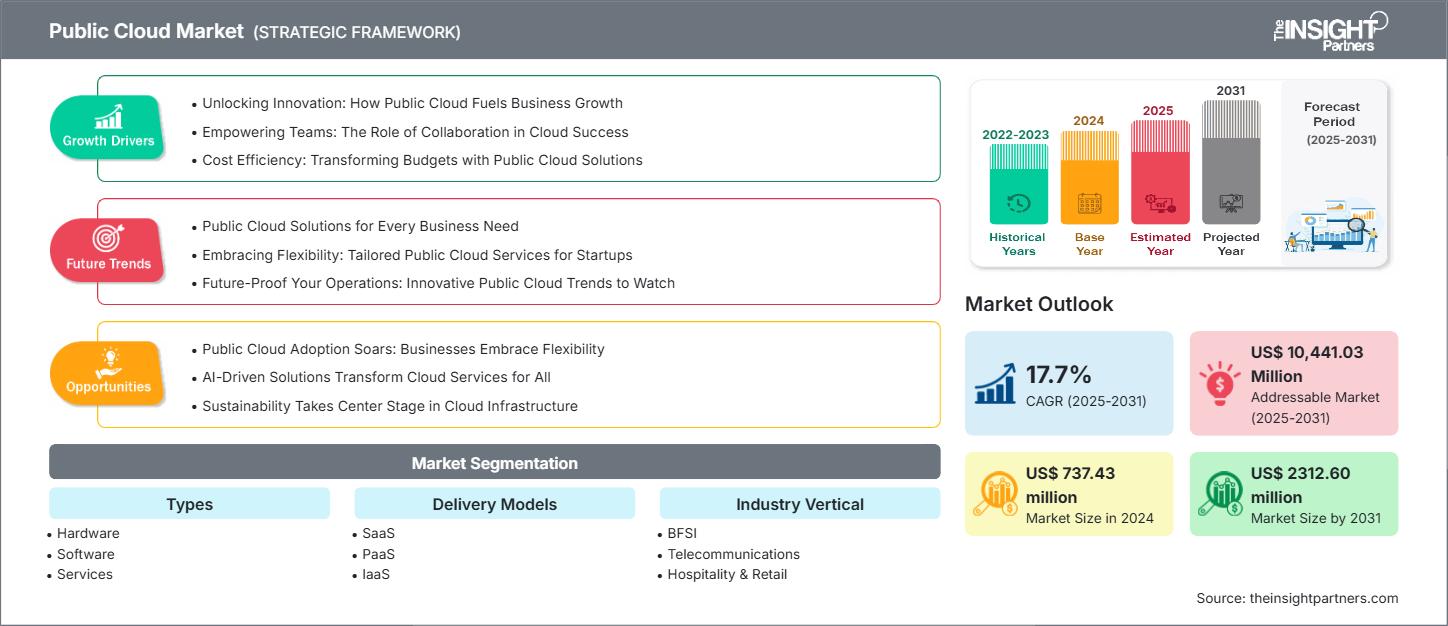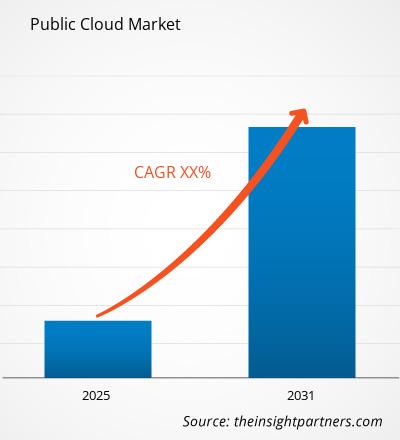Se espera que el tamaño del mercado de la nube pública alcance los 684.470 millones de dólares estadounidenses para 2031. Se anticipa que el mercado registre una CAGR del 14,8 % durante el período 2025-2031.
Los servicios en la nube actúan como proveedores externos de almacenamiento donde se almacenan los datos de la organización para diversos fines. Estos datos se recuperan posteriormente para fines analíticos. El dominio de la nube pública se refiere a los servicios en la nube que se ofrecen a través de una red pública accesible de forma remota. La mayor ventaja de este modelo es que las organizaciones tendrán menos preocupaciones con respecto al almacenamiento y el mantenimiento de los datos. La configuración es externa y la arquitectura es multiusuario, donde varias organizaciones comparten el espacio informático del proveedor externo. Las pymes obtendrán mayores beneficios al externalizar el almacenamiento y el mantenimiento de sus datos a proveedores externos de la nube, ahorrando así una gran cantidad de capital en la instalación de infraestructura. El ahorro de costos, la rápida construcción y prueba, y la menor comercialización del producto han atraído a numerosas empresas de diversos sectores a adoptar la tecnología de la nube pública.
Personalice este informe según sus necesidades
Obtendrá personalización en cualquier informe, sin cargo, incluidas partes de este informe o análisis a nivel de país, paquete de datos de Excel, así como también grandes ofertas y descuentos para empresas emergentes y universidades.
Mercado de la nube pública: perspectivas estratégicas

- Obtenga las principales tendencias clave del mercado de este informe.Esta muestra GRATUITA incluirá análisis de datos, desde tendencias del mercado hasta estimaciones y pronósticos.
Durante la última década, la industria del software ha experimentado cambios masivos. La implementación de modelos de nube por parte de las organizaciones es la más destacada debido a las ventajas que ofrece. La alta escalabilidad de las empresas las impulsa a optar por servicios basados en la nube, ya que los datos en los centros de almacenamiento pueden escalarse vertical y horizontalmente según las necesidades del usuario. Además, la estructura de precios de los proveedores de nube pública suele ser de pago por uso. Las organizaciones, especialmente las pymes, no tienen que realizar grandes pagos de una sola vez, lo que las hace muy atractivas para implementar el modelo de nube pública en sus operaciones comerciales. Conservar sus competencias principales les permite mantenerse competitivas en este mercado altamente dinámico. La reducción de los costos operativos y la amplia gama de soluciones específicas para cada negocio, ofrecidas desde una única fuente, son los principales impulsores del mercado de servicios de nube pública. La necesidad de una infraestructura de TI escalable, flexible, sencilla y eficiente también impulsa considerablemente este mercado. Se minimizan los errores humanos, ya que las operaciones son totalmente operadas por máquinas, lo que finalmente atrae a las organizaciones a adoptar los servicios de nube pública. Los factores mencionados anteriormente explican la adopción exponencial de este mercado. A pesar de su importante adopción en los países desarrollados, el crecimiento de los servicios de nube pública ha experimentado pocas limitaciones. La preocupación por la seguridad de la privacidad de los datos ha sido el principal factor limitante para este mercado. Los requisitos de conectividad a internet para este modelo de nube son elevados, y en países con mala conectividad, la implementación de la nube pública se verá afectada. Asimismo, la integración del modelo con los sistemas heredados ha sido un factor limitante. Otras limitaciones para este mercado incluyen las interrupciones del servicio y la movilidad de datos.
Perspectivas regionales del mercado de la nube pública
Los analistas de The Insight Partners han explicado detalladamente las tendencias y los factores regionales que influyen en el mercado de la nube pública durante el período de pronóstico. Esta sección también analiza los segmentos y la geografía del mercado de la nube pública en Norteamérica, Europa, Asia Pacífico, Oriente Medio y África, y Sudamérica y Centroamérica.
Alcance del informe del mercado de la nube pública
| Atributo del informe | Detalles |
|---|---|
| Tamaño del mercado en 2024 | XX mil millones de dólares estadounidenses |
| Tamaño del mercado en 2031 | US$ 684.47 mil millones |
| CAGR global (2025-2031) | 14,8% |
| Datos históricos | 2021-2023 |
| Período de pronóstico | 2025-2031 |
| Segmentos cubiertos | Por tipos
|
| Regiones y países cubiertos | América del norte
|
| Líderes del mercado y perfiles de empresas clave |
|
Densidad de actores del mercado de la nube pública: comprensión de su impacto en la dinámica empresarial
El mercado de la nube pública está creciendo rápidamente, impulsado por la creciente demanda de los usuarios finales debido a factores como la evolución de las preferencias de los consumidores, los avances tecnológicos y un mayor conocimiento de los beneficios del producto. A medida que aumenta la demanda, las empresas amplían su oferta, innovan para satisfacer las necesidades de los consumidores y aprovechan las tendencias emergentes, lo que impulsa aún más el crecimiento del mercado.

- Obtenga una descripción general de los principales actores clave del mercado de la nube pública
El mercado global de la nube pública se ha segmentado por tipos en hardware, software y servicios. Además, se ha fragmentado según el modelo de entrega en SaaS, PaaS e IaaS. Además, este mercado se ha segmentado aún más según los usuarios finales, a saber: pymes y grandes empresas. La segmentación del mercado de la nube pública también se realiza según los sectores verticales de la industria, que incluyen BFSI, telecomunicaciones, hostelería y comercio minorista, gobierno, fabricación y atención médica. América del Norte lidera el mercado global de la nube pública debido a los notables avances tecnológicos y al desarrollo socioeconómico de la región. Europa, otro importante centro industrial, ha contribuido al crecimiento del mercado de la nube pública. La región nórdica en Europa, con muchas pequeñas industrias, ha contribuido en gran medida a la participación de mercado europea en el mercado de la nube pública. Además, la región APAC está alcanzando constantemente a estas regiones, con países en desarrollo como India y China invirtiendo gradualmente en tecnologías de nube pública. Algunos de los actores clave que operan dentro del mercado global de la nube pública incluyen Microsoft Corporation, Salesforce.com, Cisco Systems, Inc., VMWare, Google, Inc., Oracle Corporation y Eucalyptus, entre otros.
- Análisis histórico (2 años), año base, pronóstico (7 años) con CAGR
- Análisis PEST y FODA
- Tamaño del mercado, valor/volumen: global, regional y nacional
- Industria y panorama competitivo
- Conjunto de datos de Excel
Informes recientes
Testimonios
Razón para comprar
- Toma de decisiones informada
- Comprensión de la dinámica del mercado
- Análisis competitivo
- Información sobre clientes
- Pronósticos del mercado
- Mitigación de riesgos
- Planificación estratégica
- Justificación de la inversión
- Identificación de mercados emergentes
- Mejora de las estrategias de marketing
- Impulso de la eficiencia operativa
- Alineación con las tendencias regulatorias






















 Obtenga una muestra gratuita para - Mercado de la nube pública
Obtenga una muestra gratuita para - Mercado de la nube pública